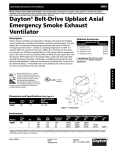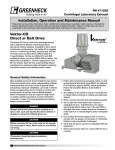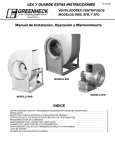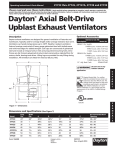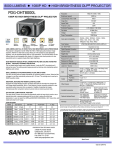Download Greenheck Fan RBUMO User's Manual
Transcript
READ AND SAVE THESE INSTRUCTIONS Models RBU/RBUMO/RDU Upblast Propeller Roof Fans Belt Drive and Direct Drive GREENHECK ® PN 455700 P.O. BOX 410 SCHOFIELD, WISCONSIN 54476-0410 PH. 715-359-6171 www.greenheck.com Installation, Operation and Maintenance Manual Greenheck Model RBU, RBUMO and RDU fans are thoroughly inspected and test run at the factory, however damage may occur during handling and shipping. Consequently, it is important that the unit be carefully inspected for visible and concealed damage before beginning installation. Report any damage to the shipper immediately. In addition, assure all accessory items are accounted for. INSTALLATION LIFTING Attach a suitable chain or strap to the four windband mounting brackets, which are designed to be used as lifting lugs (Fig. 1). Do not lift the fan by the motor, belt tube, damper frame, Fig. 1 windband or accessories. Carefully lift the fan to the roof curb and install fasteners in all holes provided in the unit base. The windband does not need to be removed for the lifting operation. Lifting Lug SERVICE ACCESS MOTOR OUT OF AIRSTREAM Model RBUMO simplifies inspection and servicing with the “motor out of the airstream” design. A removable motor cover enables quick and easy access to the motor, belt, and drives from the roof deck (Fig. 2). Servicing of propeller and bearings can easily be accomplished by removing the fan panel/windband assembly from the fan base. REMOVABLE WINDBAND By removing the bolts from the four windband mounting brackets, the windband can be removed. With the windband removed, access to the fan can be gained through the butterfly dampers. This service feature applies to models RBU, RBUMO and RDU (Fig. 1). Fig. 2 1 ELECTRICAL CONNECTIONS Before electrical connections are made, the supply voltage, phase and ampere capacity must be checked for compatibility with the fan motor. In addition, the supply wiring must be properly fused and conform to local and national electrical codes. The supply wires are then connected to an optional safety disconnect switch (if supplied) or wired directly to the motor. For belt drive units in Emergency Smoke Removal installations, the electrical supply must be kept out of the airstream. They may also require an isolated power supply so that if power is cut to the building in the event of a fire, the fan will continue to operate. Check the local and national electrical codes for emergency smoke removal fans. ** WARNING ** Disconnect and secure to the “off” position all electrical power to the fan prior to inspection or service. Caution must be used when working around the fusible link damper lifters. They may release the dampers unexpectedly. Models RBU, RBUMO and RDU may have fusible link damper lifters and all models RBUMO with high temperature options have fusible link damper lifters under spring tension. RBUMO fans UL listed as “Power ventilators for smoke control systems” in sizes 42, 48, 54 and 60 have extra heavy duty fusible link damper lifters under high spring tension that, for safety reasons, must be pinned to prevent accidental release. See Fig. 3 below for details on how to secure the lifter arms. FAILURE TO COMPLY WITH THESE SAFETY PRECAUTIONS MAY RESULT IN SERIOUS INJURY OR DEATH! For Models RBUMO with high temperature option - UL Listed WARNING ! These fans have extra heavy duty fusible link damper lifters under very high spring tension that must be pinned so they can not be accidentally tripped when servicing the fan. The fusible link damper lifters are located under the butterfly damper blades. Fig. A, shows where the safety pin MUST be placed when the fan is being serviced. Fig. B, shows where the safety pin is placed for storage when the fan is in service. Fan sizes 20, 24, 30 and 36 also have fusible link damper lifters, but they do not have the ability to be pinned when servicing due to differences in lifter designs. In either case, extreme care must be taken when working around the damper lifter assemblies or serious bodily injury or death may result. Fig. 3 Safety pins installed IMPORTANT Fig. A Electrical - This equipment must be installed with remote overload protection having adequate rating as to voltage, frequency, horsepower and full load current per phase. Where connected to a circuit protected by fuses, use time delay fuses. For supply connection use wires rated for at least 90°C (194°F) Fig. B Safety Pin Storage Locations to prevent closure while servicing fan Installation - When connecting electrical power to this fan, do not restrict motor movement. Motor must have sufficient movement for possible future belt or wheel adjustment. 00453547 Models RBUMO with High Temperature Option - UL Listed will bear the label shown at right. For fan sizes 42, 48, 54 and 60 Figs. A and B apply. 2 C UL R US LISTED VENTILATOR FOR SMOKE CONTROL SYSTEMS. 76Y9 PRESTARTING CHECKS Check all fasteners and set screws for tightness. This is especially important for bearing set screws. The propeller should rotate freely and not rub on the fan panel venturi. Rotation direction of the propeller should be checked by momentarily turning the unit on. Rotation should be in the same direction as the rotation decal affixed to the unit or as shown in Fig. 4. For 3-phase installations, fan rotation can be reversed by simply interchanging any two of the three electrical leads. For single phase installations follow the wiring diagram located on the motor. Airflow Airflow Rotation Rotation FOR BELT DRIVE FANS The adjustable motor pulley is preset at the factory for the specified fan RPM. Fan speed can be increased by closing or decreased by opening the adjustable pulley. Two or three groove variable pitch pulleys must be adjusted an equal number of turns open. Any increase in fan speed represents a substantial increase in horsepower required from the motor. Always check motor load amperage and compare to name plate rating when changing fan speed. Fig. 4 ROUTINE MAINTENANCE WARNING DISCONNECT AND SECURE TO THE “OFF” POSITION ALL ELECTRICAL POWER TO THE FAN PRIOR TO INSPECTION OR SERVICING. FAILURE TO COMPLY WITH THIS SAFETY PRECAUTION COULD RESULT IN SERIOUS INJURY OR DEATH. Once the fan has been put into operation, a periodic maintenance program should be set up to preserve the reliability and performance of the fan. Items to be included in this program are: • • • • • • BELTS BEARINGS FASTENERS SET SCREWS LUBRICATION REMOVAL OF DUST/DIRT Deflection = Belt Span Fig. 5 BELTS Belt Span 64 Premature belt failures are frequently caused by improper belt tension (either too tight or too loose) or misaligned pulleys. The proper tension for operating a V-belt is the lowest tension at which the belts will not slip at peak load conditions. For initial tensioning, the proper belt deflection half way between pulley centers is 1/64" for each inch of belt span. For example, if the belt span is 64 inches, the belt deflection should be one inch using moderate thumb pressure at midpoint of the drive (Fig. 5). Check belt tension two times during the first 24 hours of operation and periodically thereafter. To adjust belt tension, simply loosen four fasteners (two on each side of the motor plate) and slide the motor plate away from the fan shaft until proper belt tension is attained. On some fans, fasteners attaching the motor to the motor plate must be loosened in order to adjust the belt. It is very important that the drive pulleys remain in proper alignment after adjustments are made. Misalignment of pulleys will result in premature belt wear, noise, vibration and power loss. See Fig. 6. WRONG WRONG WRONG CORRECT Fig. 6 BEARINGS (For belt drive fans only) Bearings are the most critical moving part of the fan and should be inspected at periodic intervals. Locking collars and set screws, in addition to fasteners attaching the bearings to the bearing plate, must be checked for tightness. In a clean environment and temperatures above 32°F./below 200° F., fan shaft bearings with grease fittings should be lubricated semi-annually using a high quality lithium based grease. If unusual environmental conditions exist temperatures below 32°F./above 200°F., moisture or contaminants, more frequent lubrication is required. With the unit running, add grease very slowly with a manual grease gun until a slight bead of grease forms at the seal. Be careful not to unseat the seal by over lubricating or using excessive pressure. Bearings without grease fittings are lubricated for life. 3 FASTENERS AND SET SCREWS Any fan vibration has a tendency to loosen mechanical fasteners. A periodic inspection should include checking all fasteners and set screws for tightness. Particular attention should be paid to set screws attaching the propeller to the shaft and the shaft to the bearings. Loose bearing set screws will lead to premature failure of the fan shaft. LUBRICATION Refer to the paragraph on bearings for bearing lubrication. Many fractional horsepower motors installed on the smaller fans are lubricated for life and require no further attention. Motors equipped with oil holes should be oiled in accordance with the manufacturer’s instructions printed on the motor. Use a high grade SAE 20 machine oil and use caution not to over lubricate. Motors supplied with grease fittings should be greased according to directions printed on the motor. REMOVAL OF DUST AND DIRT Dirt clogs cooling openings on the motor housing, contaminates bearing lubricant and collects on propeller blades causing severe imbalance if left unchecked. The exterior surface of the motor, fan panel and entire propeller should be thoroughly cleaned periodically. Use caution and do not allow water or solvents to enter the motor or bearings. Under no circumstances should motors or bearings be sprayed with steam or water. DAMPER INSPECTION AND SERVICE CAUTION: Butterfly dampers on units supplied with optional spring lifter bars are under spring tension and will open forcefully if the fusible link is released. Butterfly dampers should be inspected for proper operation at each service interval. Check for freedom of movement and general condition of the damper blades and hinge rods. Belt Drive Fans Parts List Direct Drive Fans Parts List 9 1 1 3 2 8 2 4 5 4 5 3 7 1. 2. 3. 4. 5. 6. 7. 8. 9. 10. 11. 6 10 1. 2. 3. 4. 5. Fan Panel Propeller Drive Frame Channel (2) Motor Plate Motor Motor Pulley Shaft Pulley Fan Shaft Bearings (2) Belt Bearing Plate (Level 3 fans only - not shown) Copyright © 2000 Greenheck Fan Corp. 4 Fan Panel Propeller Drive Frame Channel (2) Motor Plate Motor IOM RBU/RBUMO/RDU Rev. 2 December 2000






